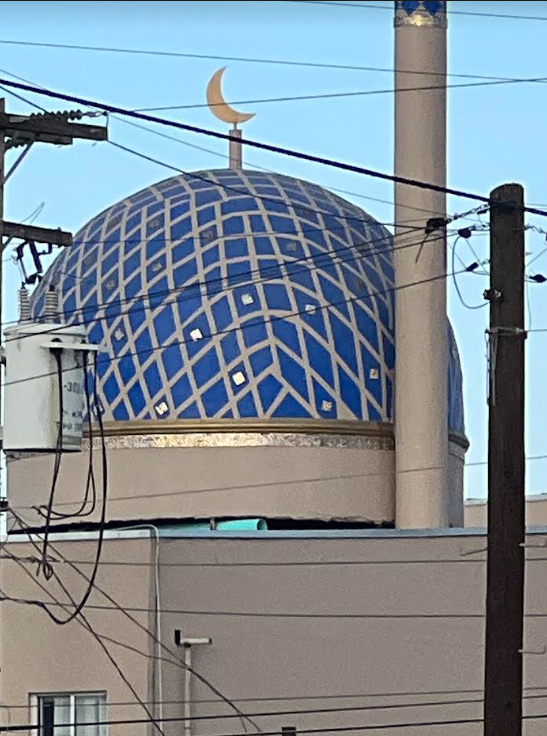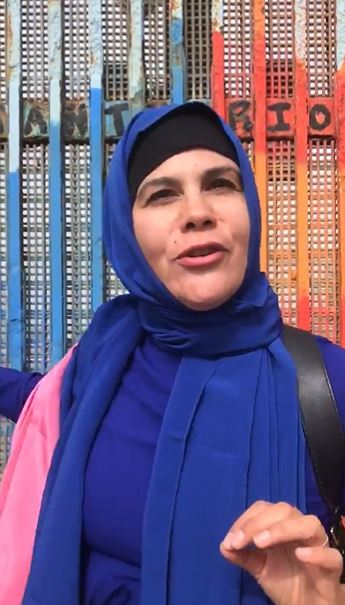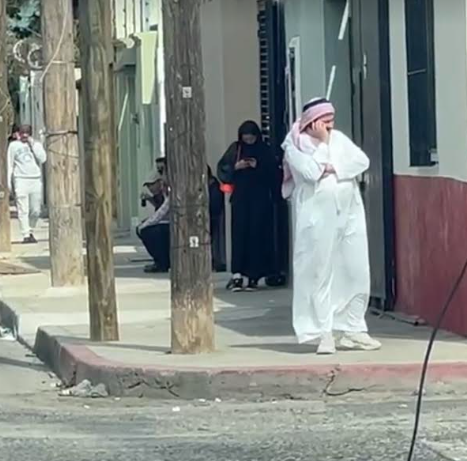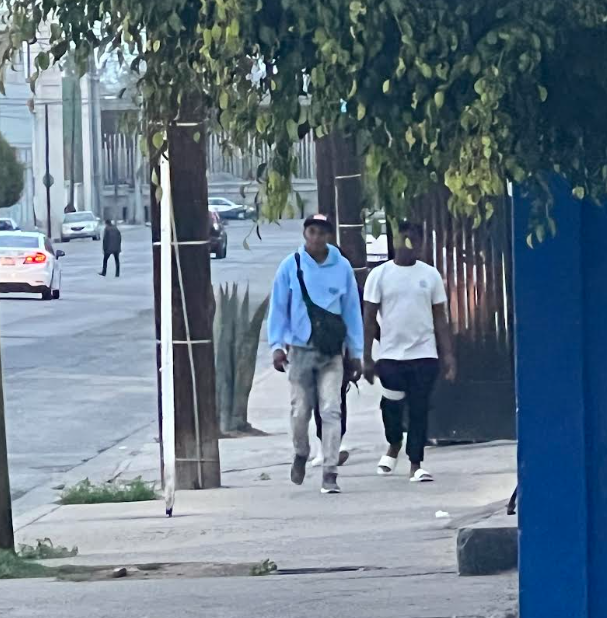
The Albergue Assabil/Mesquijta Taybah shelter in Tijuana, the first immigrant shelter in Mexico catering to U.S.-bound Muslim immigrants hoping to cross the southern border. Photo by Todd Bensman
TIJUANA, Mexico – A small blue dome, minaret and pole topped with the universal half-moon crescent symbol of Islam marks the location of an immigrant shelter waystation like no other in Mexico.
Since June 2022, the Albergue Assabil/Mesquijta Taybah shelter has operated just two blocks from where Cristóbal Colón Avenue abruptly ends at the rust-colored American border wall, which all who shelter here plan to get past one way or another.
But this combination mosque-shelter’s unique religion-based mission also distinguishes it from all other shelters in a consequential way that has gone publicly unexplored to date: as a matter of concern for American national security and terrorism.
While immigrant shelters in Tijuana and other northern Mexican border cities brim mainly with Spanish-speakers, this two-story, 8,000-square-foot former bar is the only one that expressly caters to Muslims, who arrive by taxi and Uber daily at its gated door from all over the Islamic world, including Yemen, Syria, Afghanistan, Pakistan, Lebanon, Egypt, Morocco, Tajikistan, Uzbekistan, Somalia, and other countries in the Middle East, North Africa, and South Asia.
All are headed over the border, with the shelter and non-profit migrant advocacy groups helping many exploit what CIS recently revealed was a secretive new Biden administration “humanitarian parole” program that legalizes them in Mexico and then allows Mexican authorities to discretely hand them off to American authorities at the border for resettlement. But many others choose not to avail themselves of that program and find smugglers to cross them over illegally, CIS learned.
Lately, young male Muslim immigrants from the rebellious Chechen Republic and surrounding regions where Islamist violence still occurs are using the Assabil/Mesquita Taybah shelter on their way over the American southern border, ostensibly as Ukraine war draft dodgers.
“If you’re not guilty of anything, the Americans can’t be afraid of anything,” one young bearded Chechen man told the Center for Immigration Studies recently in Tijuana a block from the shelter, in Russian via an online translation app. “I can assure the Americans that you don’t have to worry about it [terrorism]. When you need to protect the interests of Americans, I will be the first to defend those Americans. As one of our old saying says, ‘don’t bite the hand that is feeding you.’”

Chechens socialize outside the shelter in Tijuana. Photo by Todd Bensman
Still, clientele like young male Chechens elevate the shelter to a different plane because, for more than 15 years, the American homeland security establishment has officially tagged U.S.-bound immigrants from countries where Islamic terrorist groups operate as “special interest aliens,” which are supposed to trigger bilateral law enforcement screening and intelligence counterterrorism activities with Mexico to investigate them further.
In no other single shelter would special interest alien immigrants planning border crossings be drawn to congregate as they do in this one.
“I would be all over this place,” said James G. Conway, a former FBI supervisory special agent who led counterterrorism programs in Mexico after 9/11 that vetted thousands of special interest aliens.
“The fact that terrorist organizations are based in some of those countries and want to bring harm to the United States, and that this shelter that specifically caters to citizens from special interest countries two blocks from the U.S. border is helping to funnel them into the United States should certainly be a concern to law enforcement and the intelligence community,” Conway said. “I’m sure 99 percent of those who are being helped are fine but it’s that small element that could be related to a terrorist organization that is the concern.”
National security was never mentioned in the short-lived initial blast of laudatory media coverage (see here, here, and here) that welcomed the shelter’s June 2022 grand opening. The information deficit on national security questions is especially notable given that the shelter opened during an historic border crisis that saw the apprehension by the Border Patrol of a record 98 migrants who were on the FBI’s terrorism watch list during fiscal 2022 Nine more were caught crossing in October among the record-smashing four million in total who crossed in fiscal years 2021 and 2022 and at least another one million “got-aways” DHS presumes successfully crossed undetected.
No information suggests one way or another if any of these came through the Tijuana shelter. But in light of the historically high apprehensions of special interest aliens on the FBI watch list amid so many got-aways, CIS visited the Tijuana shelter over several days in November to answer unasked national security-related questions. CIS spoke with several shelter guests and conducted the first interview of its director about the sensitive national security issues the operation naturally raises for the United States.
Chief among the CIS findings is that, while American and Mexican intelligence and governments are aware of the facility’s purpose, neither has overtly sought to collect intelligence information, in any systematic way, about special interest aliens passing through with obvious, known plans to illegally cross the southern border. Nor, apparently, has either government sought systematic collaboration with the shelter’s manager, who told CIS she would gladly cooperate had either government ever asked. But neither had as of publication.
“I’m going to give the U.S. the benefit of the doubt. I can’t say unequivocally it’s off the radar,” Conway said, referring to the possibility of U.S. covert intelligence gathering. “But it would be shocking to me that an operation like this two blocks from the U.S.-Mexican border is not on the radar, considering the world we live in today.”
The shelter’s Mexico operations
The San Diego-based Latina Muslim Foundation is a registered non-profit organization in both the United States and Mexico. Its general mission is to help needy immigrant families find shelter, food and employment.

Sonia Garcia, president of the Latina Muslim Foundation, which runs the Tijuana shelter. Photo excerpted from Facebook.
During a brief 2019 border surge, foundation president Sonia Garcia, a Mexican-born convert to Islam with dual US-Mexico citizenship, saw a need in Tijuana to provide separate facilities for Muslim immigrants forced to uncomfortably mix with non-Muslim immigrants in shelters that did not heed Islamic law on cuisine, mixed-gender sleeping arrangements and modesty requirements.
When President Biden’s new policies started the current border crisis in 2021, the Latina Muslim Foundation saw demand spike for such a place and acted to realize the vision. It bought a closed nightclub in Tijuana’s north zone right near the border wall, refurbished it to include a mosque with an assigned local imam, religious education, and gender-segregated sleeping facilities, and opened for business in June 2022.
Six months later, the facility hosts from 30 to as many as 140 migrants on any given day, including families and singles, providing food, shelter, and clothing for as long as the immigrants need to cross the border in different ways.
During an hour-long interview with CIS, Garcia explained that immigrants using her Tijuana shelter use two distinct channels to cross the border.
One of these is a secretive joint U.S.-Mexico legalized “humanitarian parole” hand-off program the Biden administration discretely ramped up in early 2022 and which CIS disclosed in recent reporting. This program bestows the one-year humanitarian parole status on a rapidly growing number of immigrants while they wait in the Mexican shelter system, which is expanding due to increased demand as it is discovered worldwide.
Once all of the required documents are in order, Mexican immigration escorts the migrants right through official ports of entry to coordinated hand-offs with waiting American border officials, who admit them into the country with work authorization.
As CIS reported, this can take weeks or even a few months, as American lawyers and non-profits help shelter applicants secure the necessary psychological trauma assessments, proof-of-identity and a U.S. sponsor, and claims of victimization. The average time in her shelter was about a month to escorted handoffs of some 300 Muslim immigrants so far from countries like Afghanistan (“A lot of Afghans”, she noted), Syria, Morocco, and Egypt.
The other main channel is the illegal crossing one. Some shelter guests are unwilling, for reasons she does not feel the need to know, to go through the legal parole program with all of its waiting, interviews, and paperwork requirements.
A lot of those who decline the parole program seem to be Africans from Somalia or other countries on the continent, she said.
“If they [don’t] want to go through the program, they’re just sheltering and leaving,” Garcia said. “Of course, any shelter that has refugees, the smugglers wait for them and tell them, ‘want to go this way? I can take you easily.’ We can’t hold people. They’re free to go.”
What of U.S. National Security?
CIS asked Garcia a series of questions about what her shelter does to detect violent Islamic extremists among those who might be moving through her shelter with plans either to cross "legally" with parole or illegally over the border.
Garcia said she was well aware of the risks and that she and her staff were on the lookout for extremists and deception, albeit she acknowledged that shelter measures are not designed for the task and that “bad ones” could always slip through undetected.
“I’m not the person who is going to hide the reality of what people do, regardless of their religion,” Garcia said. “Just because they are Muslims, [we] are not going to … let them come to the United States or Mexico to hurt people. That’s it. We’re not into that. We’re just here to help people. We’re not people to bring [people in] to hurt people.”

She added: “As a Mexican and as an American, we have to work together to make sure the people who are asking for asylum are really the people who need help. And this is special for me, being on two sides of the United States and Mexico.”
As part of the humanitarian parole application program, the one where Mexico escorts pre-approved immigrants through the ports of entry for hand-offs to the Americans, Garcia said her staff conducts extensive interviews with potential applicants that include questions about their backgrounds.
“We notice when the people are in need, and we notice when the people are not in need, when their stories are real,” she said.
When they detect deception, “if the person looks nervous” amid certain outward indications extremism – such as when men refuse to talk to female staff or dress and speak certain ways – Garcia will call Mexican authorities “to give us help in the background that they may have been involved in, in their countries or somewhere.”
Asked if she meant associations with terrorist groups, Garcia answered “Yeah. Of course. Of course. That’s why we have to be conscious.”
She said she doesn’t know what, exactly, the Mexican authorities do when she calls them but assumes they contact the Americans for help and then “I get the okay, or the not okay.”
In only two instances that Garcia said she knew something about, the Mexican authorities issued “not okay.” Garcia wasn’t sure what became of those immigrants.
“It’s not my responsibility to ask them about details,” she said of the Mexican authorities.
Any opportunity for detection or calls to Mexican authorities diminishes greatly for immigrants who stay only a few nights and then leave to pay for a smuggled trip over the border. No interviews happen in those cases or chance to detect deception, nervousness, or indications of extremism.
“When they leave, they say, ‘thank you so much,’ and that’s it,” Garcia said.
Absence of proactive Mexican or American response?
As spelled out in the book America’s Covert Border War, The Untold Story of the Nation’s Battle to Prevent Jihadist Infiltration, Mexico’s collaboration with the United States on counterterrorism has been extensive and impactful -- in non-crisis times when human flows are manageable.
Mexican intelligence often runs the names of special interest aliens it catches through American security databases and allows U.S. officers into detention facilities to interview them, for instance. Mexican customs officers working in Mexican airports run identities of arriving special interest aliens through U.S. databases. Mexico has proven sensitive to U.S. requests that it deport identified extremists to home countries before they can reach the southern border.
A recent Milenio newspaper investigation based on leaked classified Mexican Ministry of National Defense documents revealed a variety of cases where Mexican and American intelligence agencies working together discovered Islamic terrorists inside Mexico in 2015, 2016, and 2017 – a number of them in Tijuana. Some were working on behalf of the Islamic State. The Milenio story details extensive Mexican collaboration with American intelligence agencies on these cases, for example on a January 2017 investigation of an Algerian in Mexico that resulted in the dismantling of an ISIS cell in Algeria. Between 2014 and 2018, Mexico's National Institute of Migration identified 19 suspected terrorists on its territory and deported them all.
However, there is increasing evidence that counterterrorism collaboration between the two countries is breaking down under the crushing weight of the highest numbers of U.S.-bound migrants ever recorded -- plus, perhaps, a lack of American interest.
“That is no longer within the scope of our criminal investigations. Because they are doing humanitarian work, they get to operate basically with impunity.”
Last fall, for instance, Mexico captured a Yemeni planning to cross into Texas who was on the FBI’s terrorism watch list but, after five months, released him when emptying its overcrowded detention centers, instead of deporting him as the Americans would normally require. Scrambling to locate the suspected terrorist, the Americans had to issue a “Be-On-the-Lookout” alert to Border Patrol in the Del Rio, Texas, area.
In Tijuana, interviews with several single male bearded Chechen immigrants in their early 20s told CIS they flew into Mexico on passports but that the Mexican customs officials let them through without delay or extra inspection. One Chechen who would only give his name as “Musa” said he’d flown on his Russian passport to Dubai, then to Brazil, then caught flights to Mexico City and, finally, a last one to Tijuana so he could stay at the shelter to think about the final move.
Musa said no one at the Mexican airport or the Assabil/Mesquijta Taybah shelter interviewed him or his other Chechen friends staying there. All would enter the United States but were using their time at the shelter to figure out how. All also said they heard about the shelter back home on social media.
Their experience passing through Brazilian and Mexican airports may indicate severe counterterrorism system stress, rather than total failure.
Garcia said Mexico recently started detaining Chechen men at the airports and deporting them to Istanbul, Turkey.
A former DHS official with extensive experience working special interest alien traffic throughout Latin America said Mexican airport screening of such immigrant arrivals is ordinarily excellent and effective and may still be working to a degree. But the fact that some Chechens are getting through Mexican airports without delay while others are being deported to Istanbul might indicate the terrorist screening system is failing.
“What I do know now is, look at the amount of people coming through!” the former DHS intelligence officer said. “No one has the capacity to screen all those people. They’re just processing people and there’s no way you can do a good job of it. If you look at the reported numbers of suspected terrorists getting caught at our border, they’re shattering records! Not even the people still in the know, know how many are getting through. But I would guess it’s a lot.”
American disinterest or inability

African Muslims staying at the shelter take a foray to shop at nearby Tijuana grocery stores. Photo by Todd Bensman
When it first opened, the shelter handled Afghans who were not admitted into American special visa programs while still in their country following the August 2021 fall of Kabul and who managed to get to the U.S.-Mexico border. For those cases, Garcia said, the American consulate office in Tijuana sent personnel to personally interview the Afghans before paroling them through the San Ysidro port into the United States.
But that has been the extent of any overt American involvement or expressed interest in the shelter, Garcia said.
Her input supports the description of DHS lack of interest in the Tijuana shelter by one active-duty intelligence officer for DHS, working inside the United States on transnational crime issues such as human smuggling. Asked point-blank if the agency was interested in criminal issues in or around the shelter, the officer quickly answered: “No. We are not.”
Asked why, the officer responded that their work was regarded as humanitarian and therefore immune from U.S. law enforcement interest.
“That is no longer within the scope of our criminal investigations. Because they are doing humanitarian work, they get to operate basically with impunity.”
For her part, Garcia said she would be happy to provide the Americans with all information the shelter maintains about every person who stays overnight – or to check what they might have on any of the more than 100 who later flagged at the U.S. border as an FBI terrorism watch list suspect.
“If somebody’s on the list and they want to find out if they came from the shelter, well they’re welcome to the come to the shelter and ask us,” she said. “We have no problem in giving the information or in hiding the information, no. If he is on the watch list and he came into the shelter, well it’s very good because we’ll give them [the Americans] the information. We’re not hiding the information.”
Asked if any American representative of law enforcement or intelligence has ever asked for information, Garcia answered, “no.”
